Peer Reveiwed Nursing Articles on Feeding a Down Syndrome Baby
Down's syndrome is the most common chromosomal bibelot, occurring in near 1 in 700 to 800 births.
What is Down's syndrome?
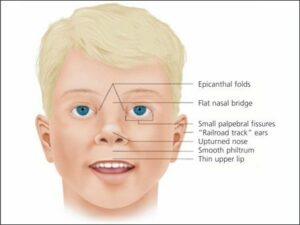
- Information technology is primarily caused by trisomy of chromosome 21, which gives ascent to multiple systemic complications as part of the syndrome.
- Langdon Downwards first described the condition in 1866, but its crusade was a mystery for many years.
- In 1932, it was suggested that a chromosomal bibelot might exist the cause, but the anomaly was non demonstrated until 1959.
Pathophysiology
Two different hypotheses have been proposed to explicate the mechanism of gene action in Down syndrome: developmental instability (ie, loss of chromosomal balance) and the so-chosen gene-dosage effect.
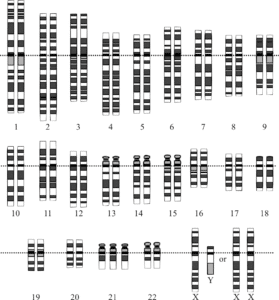
- According to the factor-dosage effect hypothesis, the genes located on chromosome 21 accept been overexpressed in cells and tissues of Down syndrome patients, and this contributes to the phenotypic abnormalities.
- Molecular analysis reveals that the 21q22.1-q22.iii region, also known as the Down syndrome critical region (DSCR), appears to contain the gene or genes responsible for the congenital heart illness observed in Down's syndrome.
- Aberrant physiologic performance affects thyroid metabolism and abdominal malabsorption; patients with trisomy 21 accept an increased risk of obesity; frequent infections are presumably due to impaired immune responses, and the incidence of autoimmunity, including hypothyroidism and rare Hashimoto thyroiditis, is increased.
- Patients with Down syndrome take decreased buffering of physiologic reactions, resulting in hypersensitivity to pilocarpine and aberrant responses on sensory-evoked electroencephalographic (EEG) tracings.
- Decreased buffering of metabolic processes results in a predisposition to hyperuricemia and increased insulin resistance.
- Children with Down syndrome are predisposed to developing leukemia, peculiarly transient myeloproliferative disorder and astute megakaryocytic leukemia.
- Musculoskeletal manifestations in patients with Down syndrome include reduced height, atlantooccipital and atlantoaxial hypermobility, and vertebral malformations of the cervical spine.
- Near 5% of patients with Down's syndrome have GI manifestations, including duodenal atresia, Hirschsprung disease, and celiac affliction.
Statistics and Incidences
Down syndrome have been observed in about all countries and races.
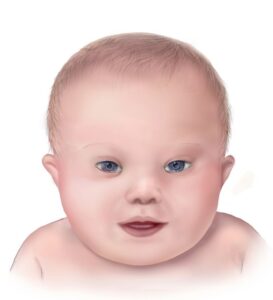
- Each year, approximately 6000 children are built-in with Down syndrome.
- Down syndrome accounts for about one-tertiary of all moderate and severe mental handicaps in schoolhouse-aged children.
- The prevalence of Downwards syndrome worldwide has increased considering of increases in lifespan in the last few decades.
- The characteristic morphologic features will exist obvious in children older than 1 year.
- On rare occasions, the disease can exist observed in a few members of a family; the run a risk for recurrence of Down syndrome in a patient'due south siblings too depends on maternal age.
- The male-to-female person ratio is slightly higher (approximately ane.15:1) in newborns with Down's syndrome, but this upshot is restricted to neonates with free trisomy 21.
- Perhaps 50% of female patients with trisomy 21 are fertile, and these females accept up to a 50% chance of having a live child who also has trisomy 21.
Causes
The cause of DS is not known, although several theories dominate.
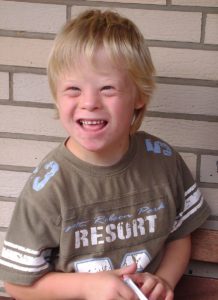
- Down syndrome is caused by the following 3 cytogenetic variants: 3 full copies of chromosome 21, a chromosomal translocation that results in three copies of the critical region for Down syndrome, and mosaicism.
- Full copies of trisomy 21. A free trisomy 21 results from nondisjunction during meiosis in ane of the parents; this occurrence is correlated with advanced maternal and paternal age.
- Translocation. Translocation occurs when genetic material from chromosome 21 becomes attached to another chromosome, resulting in 46 chromosomes, with ane chromosome having extra material from chromosome 21 attached.
- Mosaicism. Mosaicism is considered a postzygotic event (ie, one that occurs after fertilization); near cases result from a trisomic zygote with mitotic loss of 1 chromosome; as a result, ii cell lines are found: ane with a free trisomy and the other with a normal karyotype; this finding leads to great phenotypic variability, ranging from nigh normal to the archetype trisomy 21 phenotype.
Clinical Manifestations
On physical examination, patients with trisomy 21 have characteristic craniofacial findings, such as the post-obit:
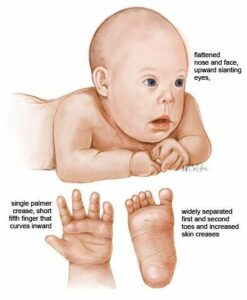
- Flat occiput and a flattened facial appearance. This is more often than not recognized past the time the kid turns 1 yr old or more than.
- Pocket-sized brachycephalic head. Brachycephaly or shortness of head is a mutual manifestation.
- Epicanthal folds. Epicanthal folds at the inner bending of the optics are present.
- Apartment nasal bridge. Some other common manifestation is the short, flattened bridge of the nose of the child.
- Upward-slanting palpebral fissures. There is an "almond-shaped" appearance of the optics.
- Brushfield spots. Brushfield spot is the speckling of the iris.
- Minor nose and pocket-size rima oris. The kid is often identified as having a modest nose and oral cavity.
- Protruding tongue. The protruding tongue is thick and fissured.
- Small and dysplastic ears. The child's ears are also small and dysplastic.
- Generous nuchal skin. The child's skin is dry, cracked, and fissured, and may be mottled.
Cess and Diagnostic Findings
The diagnosis of Down syndrome is most usually made past prenatal screening followed by definitive diagnostic testing.
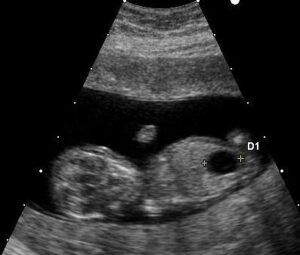
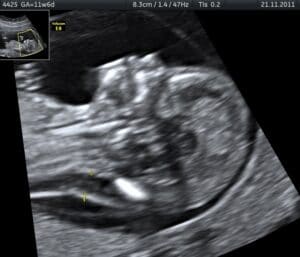
- Laboratory studies. A complete blood count (CBC) with differential and bone marrow examination to rule out leukemia is indicated; thyroid-stimulating hormone (TSH) and thyroxine (T4) levels should be obtained at birth, at six and 12 months, and annually thereafter, to rule out hypothyroidism; and perform Papanicolaou smears every 1-3 years in sexually agile women starting at the age of first intercourse.
- Cytogenetic studies. The clinical diagnosis of trisomy 21 should exist confirmed with cytogenetic studies; karyotyping is essential to make up one's mind the risk of recurrence; in translocation Down syndrome, karyotyping of the parents and other relatives is required for proper genetic counseling.
- Fluorescence in situ hybridization (FISH). Fluorescence in situ hybridization (FISH) may be used for rapid diagnosis of trisomy 21; information technology can be successful in both prenatal diagnosis and diagnosis in the neonatal period; a FISH study will discover the presence of trisomy 21; however, it does not provide information most whether trisomy 21 is secondary to a translocation. therefore, a FISH exam must be confirmed by a complete karyotype analysis.
- Prenatal screening and diagnosis. Prenatal screening using a combination of maternal serum biomarkers and ultrasonography can discover upwardly to 95% of pregnancies affected by Down's syndrome.
- Nuchal translucency (NT) scan. The nuchal translucency (NT) scan assesses the amount of fluid in the dorsum of the fetal cervix and is best assessed at xi-14 weeks; an increased NT measurement is associated with an increased risk of genetic syndromes and can find up to 70% of Down syndrome pregnancies.
- Amniocentesis. Amniocentesis, routinely performed at xiv-16 weeks' gestation, remains the criterion standard of invasive diagnostic tests. Testing for chromosomal disorders is 99.5% accurate.
- Chorionic villus sampling (CVS). Chorionic villus sampling (CVS) is performed at ten-xiii weeks' gestation; before testing is idea to be associated with a 1 in 300-chiliad risk of fetal transverse limb deficiency, a modest gamble of maternal jail cell contamination, and a 0.5-1% chance of a fetal loss after the procedure.
Medical Management
Despite connected work, no notable medical treatments for intellectual disability associated with Down syndrome accept been forthcoming. Nonetheless, the dramatic improvements in medical care described beneath have greatly improved the quality of life for patients and increased their life expectancy.
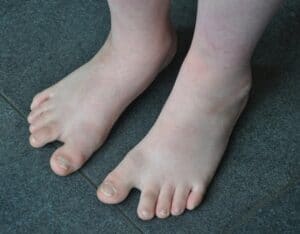
- Surgical care. Timely surgical treatment of cardiac anomalies, detected during the newborn menstruation or early infancy, may exist necessary to prevent serious complications and is crucial for optimal survival; surgical intervention may be necessary to reduce atlantoaxial subluxation and to stabilize the upper segment of the cervical spine if neurologic deficits are clinically significant; congenital cataracts occur in near 3% of children and must be extracted soon subsequently nativity to allow lite to reach the retina.
- Nutrition. No special diet is required unless celiac disease is present. A balanced diet and regular exercise are needed to maintain appropriate weight; feeding problems and failure to thrive unremarkably improve subsequently cardiac surgery.
- Activity. No restriction of activities is necessary; parents should be counseled about sports with an increased risk of spinal injuries, such as football, soccer, and gymnastics; propose the patient to exercise to maintain an appropriate weight.
Pharmacologic Management
The standard immunizations and well-child care should be provided. In addition, specific manifestations of the syndrome and associated conditions must be addressed, as follows:
- Thyroid hormone. Give thyroid hormone for hypothyroidism to forestall intellectual deterioration and to improve the individual's overall role, academic achievement, and vocational abilities
- Digitalis and diuretics. Requite digitalis and diuretics every bit necessary for cardiac direction.
- Vaccines. Consider pneumococcal and flu vaccination for children with chronic cardiac and respiratory disease; consider prophylactic palivizumab, since infants with Down syndrome are at loftier risk for hospitalization with a respiratory syncytial virus.
- Anticonvulsants. Administer anticonvulsants for tonic-clonic seizures or for infantile spasms (treat with steroids).
Nursing Management
Nursing management for a child with Downwardly syndrome are:
Nursing Assessment
Assessment of a child with Downward syndrome include:
- Physical assessment. The nurse should perform a thorough, systemic, head-to-toe assessment of the newborn.
- History. Nurses should obtain a history of female parent'south pregnancy, birth history, and genetic testing.
Nursing Diagnoses
Based on the assessment data, the major nursing diagnoses are:
- Delayed growth and evolution related to impaired ability to achieve developmental tasks.
- Cocky-care arrears: bathing and hygiene, dressing, feeding, toileting related to cognitive impairment.
- Impaired verbal communication related to impaired receptive or expressive skills.
- Adventure for infection related to decreased muscle tone and poor drainage of mucus.
Nursing Intendance Planning and Goals
The major goals for a kid with Down syndrome are:
- The child will be able to perform motor, social, and/or expressive skills typical of age group inside the scope of present capabilities.
- The child will perform cocky-care and cocky-command activities appropriate for age.
- The child will be able to institute a method of communication in which needs tin be expressed.
- The child will be able to accomplish timely wound healing; exist free of purulent drainage or erythema, and be afebrile.
Nursing Interventions
Nursing interventions are:
- Provide adequate nutrition. Assess the child' ability to consume, provide data on the proper mode of giving food, and provide good nutrition counseling.
- Frequent consultations are a must. Encourage parents to have the child's hearing and vision checked regularly.
- Assess agreement of Down syndrome. Educate the parents about Down's syndrome and the intendance of a child with the affliction.
- Provide emotional back up and motivation. The family caregiver needs support during these trying times; they need stiff back up and guidance from the time the child is born.
Evaluation
Goals are met as evidenced by:
- The child was able to perform motor, social, and/or expressive skills typical of age group within the scope of present capabilities.
- The child performed self-care and self-command activities advisable for age.
- The kid was able to constitute a method of communication in which needs tin can be expressed.
- The child was able to achieve timely wound healing; exist free of purulent drainage or erythema, and exist afebrile.
Documentation Guidelines
Documentation in a kid with Down's syndrome include:
- Availability and use of support systems and community resources.
- Plan of care.
- Teaching plan.
- Attainment or progress toward desired outcomes.
- Deviations from normal parenting expectations.
Do Quiz: Down's syndrome
Here'south a v-item quiz for Down Syndrome study guide. Delight visit our nursing test banking concern page for more NCLEX practice questions.
1. Which of the following assessment findings would lead the nurse to suspect Down syndrome in an infant?
A. Transverse palmar pucker
B. Small tongue
C. Large nose
D. Restricted joint move
one. Answer: A. Transverse palmar pucker.
- Option A: Down syndrome is characterized by the following a transverse palmar crease (simian crease), separated sagittal suture, oblique palpebral fissures, small nose, depressed nasal bridge, loftier arched palate, backlog and lax peel, wide spacing and plantar crease betwixt the second and big toes, hyperextensible and lax joints, large protruding tongue, and muscle weakness.
- Selection B: The child with Down syndrome has a protruding tongue that is thick and fissured.
- Option C: A modest nose is manifested by children with Down syndrome.
- Option D: There is no restricted joint movement, rather the child has articulation hyperextensibility or hyper-flexibility.
two. When planning care for an 8-year-old boy with Down's syndrome, the nurse should:
A. Plan interventions co-ordinate to the developmental levels of a five-yr-erstwhile because the child will have developmental delays.
B. Programme interventions according to the developmental level of a 7-twelvemonth-onetime child because that's the child's age.
C. Straight all teaching to the parents because the child can't understand.
D. Assess the child'due south current developmental level and program intendance accordingly.
2. Reply D. Assess the child'southward current developmental level and plan care accordingly.
- Selection D: Because children with Downward syndrome can vary from mildly to severely mentally challenged, each child should be individually assessed.
- Options A & B: Nursing intendance plan should exist planned according to the developmental age of a child with Down's syndrome, non the chronological age.
- Option C: A child with Down's syndrome is capable of learning, especially a child with mild limitations.
3. A nurse is monitoring the intake and output of a toddler with Downwardly syndrome receiving furosemide (Lasix) IV. Which of the post-obit method is the most appropriate for measuring the urine output?
A. Weighing the diaper.
B. Insert Foley catheter.
C. Enquire the mother regarding the number of diaper changes.
D. Compare intake with output.
3. Reply: A. Weighing the diaper.
- Option A: The most appropriate method for measuring urine output of an baby is by weighing the diaper.
- Option B: Inserting a Foley catheter volition provide the most accurate measurement but it gives the babe the hazard of urinary tract infection.
- Options C & D: These will not provide the authentic measurement of the urine output.
4. Dustin who was diagnosed with Down syndrome has Hirschsprung'due south affliction. He developed fever and watery explosive diarrhea. Which of the following would Nurse Joyce do kickoff?
A. Monitor the child every xxx minutes.
B. Notify the dr. immediately.
C. Administrate an anti-diarrheal.
D. Nothing. (These findings are common in Hirschsprung'southward affliction.)
4. Answer: B. Notify the physician immediately.
- Option B: For the kid with Hirschsprung's disease, fever and explosive diarrhea signal enterocolitis, a life-threatening situation. Therefore, the physician should exist notified directly.
- Option A: The kid is acutely ill and requires intervention, with monitoring more than frequently than every 30 minutes.
- Selection C: Mostly, because of the intestinal obstruction and inadequate propulsive intestinal movement, antidiarrheals are not used to treat Hirschsprung's disease.
- Option D: Hirschprung'southward disease typically presents with chronic constipation.
5. A patient with Down's syndrome recently started on phenytoin (Dilantin) to control simple complex seizures is seen in the outpatient clinic. Which information obtained during his chart review and assessment will be of greatest concern?
A. The gums appear enlarged and inflamed.
B. The white blood cell count is 2300/mm3.
C. Patient occasionally forgets to have the phenytoin until after lunch.
D. A patient wants to renew his driver's license in the adjacent month.
5. Answer: B. The white blood cell count is 2300/mm3.
- Selection B: Leukopenia is a serious side effect of phenytoin and would require discontinuation of the medication.
- Options A, C, D: The other data indicate a need for further cess and/or patient educational activity, but volition not crave a alter in medical treatment for the seizures.
See Too
Related topics to this written report guide:
- Pediatric Nursing Study Guides
- Nursing Notes: Report Guides for Various Topics
- Pediatric Nursing NCLEX Practice Questions
Farther Reading
Recommended resources and books for pediatric nursing:
- PedsNotes: Nurse's Clinical Pocket Guide (Nurse's Clinical Pocket Guides)
- Pediatric Nursing Made Incredibly Easy
- Wong'southward Essentials of Pediatric Nursing
- Pediatric Nursing: The Critical Components of Nursing Care
Source: https://nurseslabs.com/down-syndrome-trisomy-21/
0 Response to "Peer Reveiwed Nursing Articles on Feeding a Down Syndrome Baby"
Postar um comentário